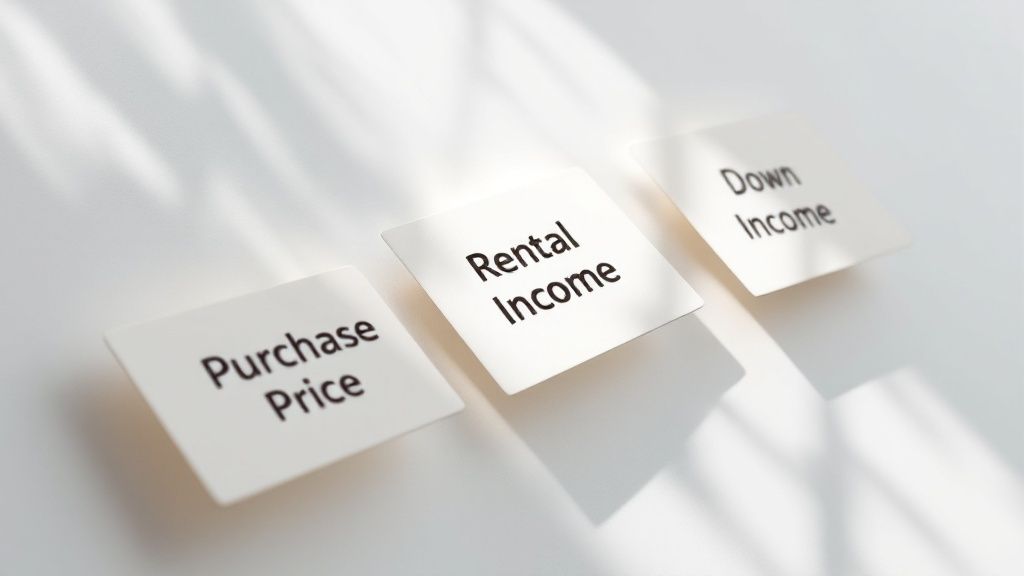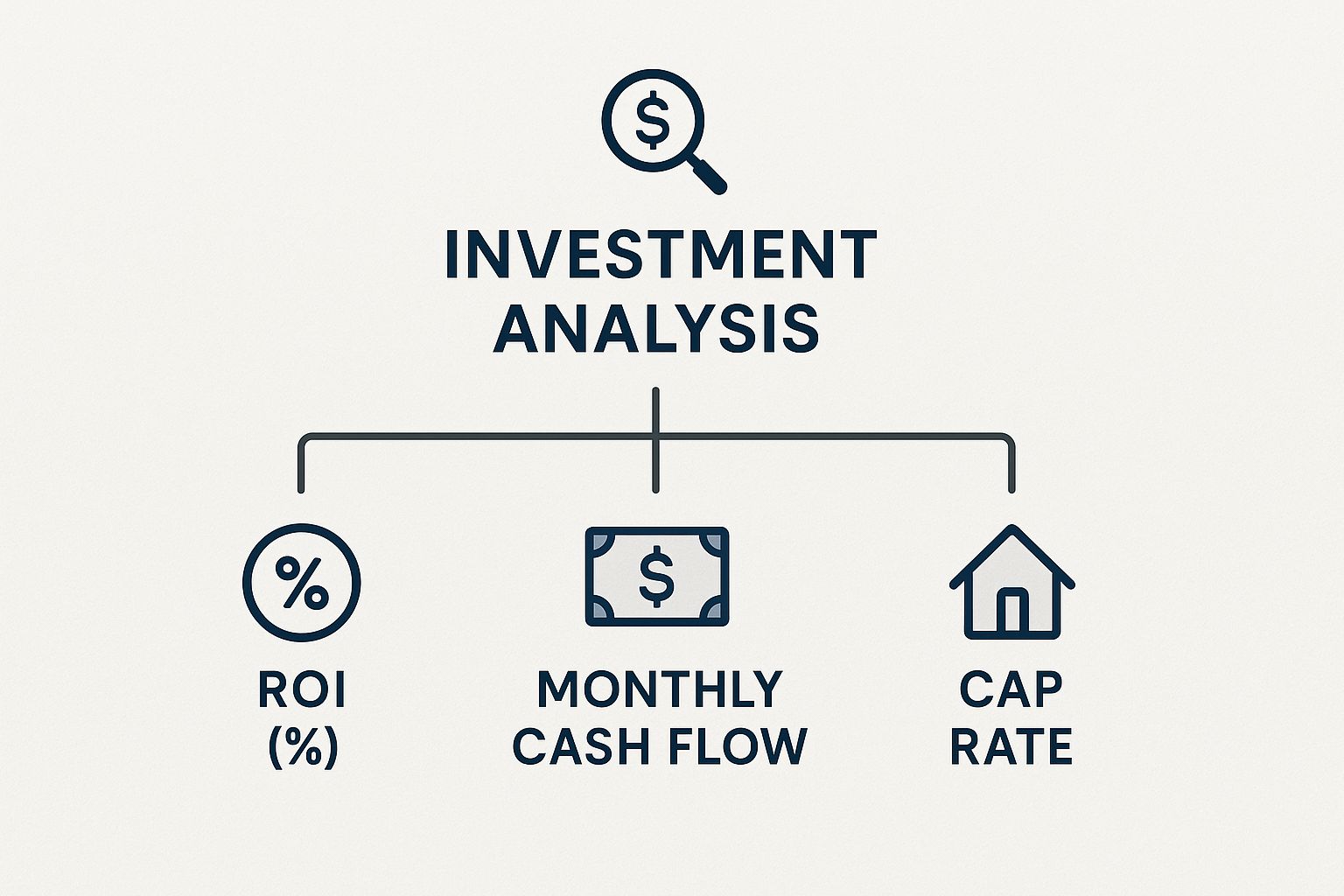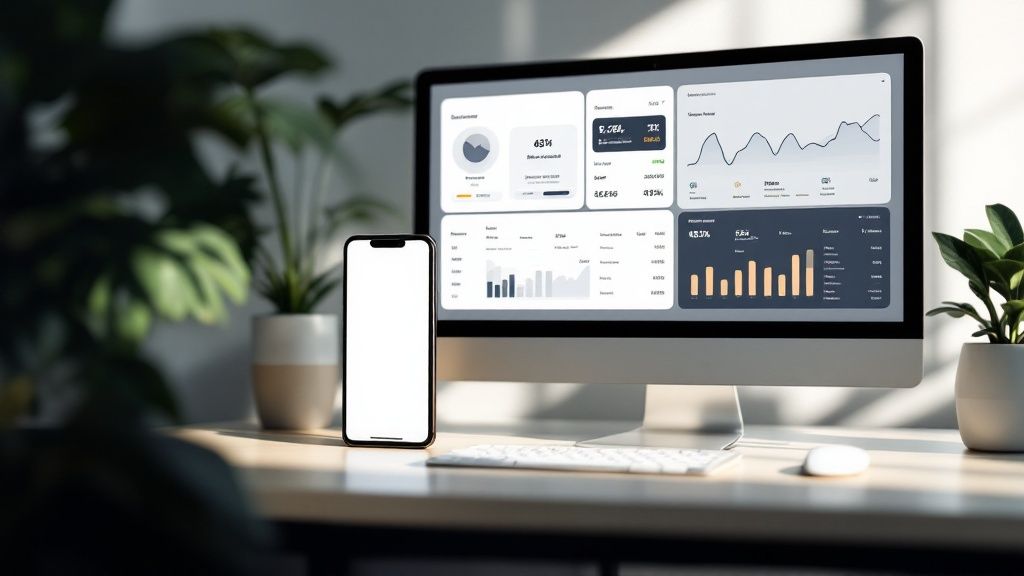A real estate investment calculator is the tool that turns raw property data into something you can actually use: clear, actionable numbers like cash flow and ROI. It’s what takes you from hopeful guessing to making confident, data-backed decisions, letting you see a deal's real potential before putting a single dollar on the line.
Why Smart Investors Never Guess

Investing in real estate without running the numbers is like trying to navigate the ocean without a compass. You might end up somewhere, but it's probably not where you intended to go. Successful investors don't ride waves of market hype or follow gut feelings; they trust the math. A good real estate investment calculator is that financial compass, pointing you toward profitable deals and steering you clear of costly mistakes.
These tools cut through the noise of property finance. They translate overwhelming concepts—like Return on Investment (ROI), Cash on Cash Return, and Internal Rate of Return (IRR)—into concrete figures you can build a business plan around. Instead of drowning in variables, you get a clear, simple picture of a property's potential.
The Problem with Guesswork
In a market driven by data, relying on intuition alone is a high-stakes gamble. Without running the numbers, it's incredibly easy to:
- Overlook hidden expenses: Maintenance, vacancy rates, and property management fees can quietly eat away at your profits until there's nothing left.
- Misjudge cash flow: A property might look good on paper, but a calculator will tell you if it actually generates positive income each month after every single bill is paid.
- Fail to compare opportunities: It's almost impossible to accurately weigh two different properties against each other without a standardized way to measure their financial performance.
A data-driven approach pulls emotion out of the deal. It allows you to build a predictable, profitable portfolio one calculated decision at a time. This is the first real step from being just a hopeful buyer to becoming a confident analyst.
A Market of Opportunity
The global real estate market is always in motion, creating both risks and massive opportunities for investors who are prepared. In just one recent quarter, direct real estate transactions hit around US$179 billion globally, a 14% jump from the previous year. With that much capital flying around, investors who use precise tools to analyze deals gain a serious competitive edge.
Ultimately, using a real estate investment calculator is about replacing uncertainty with clarity. Tools that offer automated property analysis can save you countless hours of manual work, giving you the instant insights needed to act fast and with conviction. This guide will put you on the path to understanding the real numbers behind any deal you look at.
Decoding Your Calculator Inputs

A real estate investment calculator is an incredible tool, but it's not a magic box. The analysis it spits out is only as good as the numbers you feed into it. Think of it as a high-performance engine: it needs clean, premium fuel to perform.
There’s an old saying in data analysis: "garbage in, garbage out." It’s brutally true in real estate. Let's break down the essential inputs, piece by piece, so you can stop guessing and start making decisions with confidence.
The Foundational Numbers
Before you even think about profit, you have to nail down the core structure of the deal. These are the big-ticket items that form the bedrock of your entire investment.
- Purchase Price: This is the big one—the price you agree to pay for the property. It's the starting line for almost every other calculation.
- Down Payment: This is your skin in the game. It's the cash you bring to the table. A bigger down payment means a smaller loan, which directly translates to better monthly cash flow.
- Loan Details: This isn't just one number. You need the interest rate, the loan term (like 30 years), and any closing costs rolled into the financing. These figures dictate your mortgage payment, which is usually your largest single expense.
Don't underestimate how much these numbers matter. Even a half-point difference in your interest rate can mean tens of thousands of dollars over the life of the loan.
The Revenue Engine: Operating Income
Operating income is the lifeblood of a rental property. It’s all the money the property brings in before you subtract any of your costs. You need to be brutally realistic here, not an optimist.
Here are the main sources:
- Gross Rental Income: This is the total rent you'd collect if the property was 100% occupied for the entire year. To get this right, you need to research what comparable units are actually renting for in the neighborhood right now.
- Other Income: Don’t overlook the small stuff. This can be anything from coin-op laundry machines, assigned parking spots, pet fees, or charging tenants for utilities. It all adds up.
Always—and I mean always—base your rent projections on hard market data, not what you wish you could get. Overestimating rent is the number one rookie mistake that sinks deals.
The Cost of Doing Business: Operating Expenses
This is where the rubber meets the road. Operating expenses are all the recurring costs needed to keep the lights on and the property running smoothly, excluding your mortgage payment. A good calculator forces you to confront these costs head-on.
Here are the expenses you absolutely cannot forget:
- Property Taxes: This one’s non-negotiable. You can find the exact figure from the local county assessor's website or the property's tax history.
- Insurance: Call a local agent and get a quote for a landlord or hazard policy. Rates can swing wildly based on location, property condition, and the coverage you choose.
- Maintenance and Repairs: Things break. Faucets leak, toilets run, and drywall gets damaged. A solid rule of thumb is to budget 1% of the property's value each year just for this.
- Capital Expenditures (CapEx): This is different from maintenance. CapEx is for the big, expensive stuff that has a long lifespan but will eventually need replacing—think a new roof ($10,000+), an HVAC system ($8,000+), or a water heater ($1,500+).
- Vacancy Loss: No property stays rented 100% of the time. People move out. It takes time to find new tenants. A conservative estimate for vacancy is usually between 5% and 10% of your gross rental income.
- Property Management Fees: If you’re not managing it yourself, you’ll pay a pro. This typically runs 8-12% of the monthly rent they collect.
For fix-and-flip or BRRRR deals that need heavy lifting, a detailed renovation budget is mission-critical. To get a handle on those numbers, you need to learn how to estimate renovation costs accurately.
Mastering these inputs is what separates amateurs from pros. It ensures your calculations reflect reality and gives you the rock-solid confidence you need to pull the trigger on the right deals.
Understanding the Metrics That Matter
Once you plug your numbers into a real estate investment calculator, it spits back a handful of performance metrics. These aren't just random percentages; they're the vital signs of a property's financial health. To make smart moves, you have to know what these numbers are actually telling you.
Let's cut through the dense formulas and talk about the three core metrics that truly matter. We'll use simple analogies to make them stick, so you can look at any deal and understand its potential with total confidence.

This high-level view shows how a full analysis breaks down. Think of ROI, cash flow, and cap rate as different lenses, each giving you a unique perspective on the same property.
Cash on Cash Return: Your Annual Paycheck
Think of Cash on Cash (CoC) Return as your investment's annual paycheck. It's the most direct metric out there, and it answers one simple question: "For every dollar of my own cash I put into this deal, how much cash do I get back each year?"
It strips everything else away and focuses only on the relationship between the actual cash you invested (your down payment, closing costs, and initial rehab funds) and the annual pre-tax cash flow the property spits out. CoC doesn't care about appreciation, tax benefits, or the principal you pay down. It's all about immediate, tangible cash returns.
For many investors, especially those laser-focused on building passive income, CoC is the number one metric. A solid CoC return for a rental usually starts in the 8-12% range, but this can swing wildly depending on your market and strategy.
Return on Investment: The Total Scorecard
If CoC is your annual paycheck, then Return on Investment (ROI) is the total scorecard. It zooms out to give you a more complete picture of your investment's performance because it tracks more than just cash flow.
ROI doesn't just look at the cash your property generates; it also includes the equity you're building. This equity comes from two places:
- Loan Paydown: Every mortgage payment you make is like a forced savings account, increasing your ownership stake.
- Appreciation: This is the slow (or sometimes fast) climb in your property's market value over time.
Because it folds in these other wealth-building components, your ROI will almost always be higher than your CoC return. It helps you see the total financial gain of owning the asset, not just the cash it puts in your pocket today. This makes it essential for evaluating any long-term buy-and-hold play.
Internal Rate of Return: The Investor’s Secret Weapon
Finally, we have the Internal Rate of Return (IRR). This one is a bit more advanced, but it’s an investor's secret weapon for comparing completely different types of deals over their entire lifespan. Think of IRR as the ultimate financial tie-breaker.
What makes IRR so powerful is that it understands the time value of money. Simply put, a dollar today is worth more than a dollar tomorrow. IRR calculates the true annualized rate of return by looking at all cash inflows (rent, final sale) and outflows (purchase, expenses) and when they occur over the entire holding period.
This makes it the perfect tool for answering questions like:
- Is a 5-year fix-and-flip project a better use of my capital than a 10-year rental?
- Between these two different rental properties, which one will actually be more profitable over the next 7 years?
IRR levels the playing field, letting you compare apples to oranges with financial precision. While the math is complex, a good real estate investment calculator does all the heavy lifting for you. For a deeper dive into the mechanics, check out our guide on the most critical real estate math formulas.
Key Investment Metrics at a Glance
To keep these straight, here's a quick comparison of the three core metrics every investor needs to know.
| Metric | What It Measures | Best Used For | Key Consideration |
|---|---|---|---|
| Cash on Cash (CoC) | Annual cash income relative to the actual cash you invested. | Evaluating immediate cash flow and the efficiency of your initial capital. | Ignores appreciation, loan paydown, and tax benefits. |
| Return on Investment (ROI) | Total profit (cash flow + equity gain) relative to your total investment cost. | Assessing the overall long-term profitability of a buy-and-hold investment. | Doesn't account for the time value of money. |
| Internal Rate of Return (IRR) | The annualized rate of return, factoring in the timing of all cash flows. | Comparing different investment opportunities with varied timelines and cash flow patterns. | The calculation is more complex and sensitive to assumptions about the future sale price. |
Each metric tells a different part of the story. A savvy investor knows how to use all three to get a complete, 360-degree view of a deal's potential before putting any money on the line.
A Practical Walkthrough: Analyzing a Duplex
Knowing the concepts is one thing, but building real confidence means getting your hands dirty with actual numbers. This is where we bridge the gap between abstract ideas and a real-world deal, showing you exactly how a real estate investment calculator turns a list of specs into a clear financial roadmap.
We'll walk through a classic investment property: a duplex. By crunching the numbers together, you'll see just how fast you can size up a deal and get a feel for its potential.
Step 1: Gather Your Data
First things first, we need to gather our data—the raw ingredients for our financial recipe. A solid analysis always starts with realistic, well-researched numbers, not wishful thinking.
Here’s the profile for our example duplex:
- Purchase Price:$400,000
- Down Payment:25% ($100,000)
- Loan Amount:$300,000 at 6.5% interest over 30 years
- Closing Costs:3% of purchase price ($12,000)
- Initial Repairs:$8,000 for new paint and flooring
These figures tell us exactly what it takes to get in the door. The total cash out of your pocket is the down payment plus closing costs and repairs, which adds up to $120,000. This number is critical—it’s the denominator for our Cash on Cash Return.
Step 2: Project Income and Expenses
Next up, we figure out how the property will perform month after month. This part requires some homework on the local market to make sure our projections are grounded in reality.
Projected Monthly Income:
- Each unit rents for $1,600/month.
- Total Gross Monthly Rent: $3,200
Estimated Monthly Expenses:
- Property Taxes:$400 (or $4,800 annually)
- Insurance:$150 (or $1,800 annually)
- Vacancy:5% of gross rent ($160)
- Repairs & Maintenance:8% of gross rent ($256)
- Capital Expenditures (CapEx):5% of gross rent ($160)
- Property Management:10% of gross rent ($320)
With these numbers laid out, we get a clear picture of the property’s operational health before we even factor in the mortgage payment. Now we're ready for the easy part.
Step 3: Enter Data into the Calculator
This is where a tool like the FlipSmart real estate investment calculator does the heavy lifting. You just plug each number into its designated field. The calculator takes your raw data and instantly organizes it into a powerful analysis.
Here’s what our duplex numbers look like once they’re entered, giving you a clean visual breakdown of the entire deal.
The calculator takes these inputs and immediately spits out the key metrics you need to make a smart, informed decision.
Step 4: Interpret the Results
This is the moment of truth. What are the numbers really telling you? The calculator’s output is the financial story of your potential investment.
For our duplex, let's say the calculator gives us these core metrics:
Monthly Cash Flow:$201
Cash on Cash Return:8.04%
10-Year ROI:15.2%
So, what does this mean for your goals?
An 8.04% Cash on Cash Return tells you that for the $120,000 cash you put in, you can expect to get $9,648 back in your pocket in the first year. It answers the question: "Is this annual 'paycheck' worth my initial investment?" For most long-term rental investors, anything over 8% is a pretty solid starting point.
The projected 15.2% 10-Year ROI gives you the bigger picture. It shows that when you account for not just cash flow but also the equity you build as tenants pay down your loan—plus a conservative estimate for property appreciation—your total return is much stronger. This is the metric that tells you if the property aligns with your long-term wealth strategy. It answers the question: "Is this a good place to park my capital for the next decade?"
This step-by-step process—from gathering your numbers to making sense of the results—is how you move past analysis paralysis. It provides a reliable framework to evaluate any deal quickly and accurately, giving you the confidence to pull the trigger or walk away.
Avoiding Common Calculator Pitfalls

A powerful real estate investment calculator is an incredible asset, but it’s not magic. It can't tell the difference between good data and bad data. The most common reason a deal goes south isn't a faulty tool—it's flawed assumptions and overly optimistic numbers.
Even seasoned pros can fall into these traps, turning what looked like a home run on paper into a serious financial headache. Understanding these common mistakes is the first step toward building a more realistic, bulletproof analysis. It’s all about stress-testing your numbers to see if they can survive the real world.
The Hidden Costs That Sink Profits
One of the quickest ways to kill your returns is by underestimating the true cost of owning a property. New investors nail down the mortgage, taxes, and insurance but completely gloss over the everyday expenses that slowly bleed a property’s cash flow.
- Underbudgeting Repairs: This is a classic rookie mistake. A property might look fantastic during a walkthrough, but what about that 15-year-old furnace? Or the water heater that's on its last legs? A single big-ticket replacement, like a new HVAC system for $8,000, can wipe out an entire year of projected profits in one shot.
- Ignoring Capital Expenditures (CapEx): Repairs are for fixing things that break unexpectedly. CapEx is for replacing things that wear out over time. You absolutely must set aside money every single month for the inevitable roof replacement, new appliances, or driveway repaving down the road.
A conservative rule of thumb is the "1% Rule" for maintenance, where you budget 1% of the property's purchase price for annual repairs. For CapEx, many investors set aside an additional 5-10% of gross rents.
The Dangers of Unrealistic Projections
Optimism is great, but in real estate analysis, it can be your worst enemy. Basing your calculations on best-case scenarios is a surefire way to end up disappointed. The market is unpredictable, and your numbers need a buffer to absorb the shocks.
The two most dangerous assumptions are:
- Overly Aggressive Rent Growth: Assuming rents will jump 5-10% every single year is a massive gamble. Instead, base your future projections on historical local averages, which are often far more modest.
- Forgetting About Vacancy: No property stays occupied 100% of the time. Period. Factoring in a vacancy rate of at least 5% (or more, depending on your market) is non-negotiable for an accurate cash flow forecast.
Even with market ups and downs, the global outlook for real estate remains strong. A recent Deloitte report noted a recovery in commercial real estate, with the S&P Global property index showing a 14.1% total return over the past year. This is driven by real estate's power as an inflation hedge, which only reinforces why accurate, conservative analysis is so critical. You can dig deeper into these commercial real estate trends and the global outlook on Deloitte's website.
At the end of the day, a real estate investment calculator is a truth machine. But to get the truth out, you have to put honest, well-researched, and conservative numbers in. By sidestepping these common pitfalls, you turn your analysis from a hopeful guess into a reliable financial forecast.
Frequently Asked Questions
When you're diving into the world of real estate, you're bound to have questions. Here are some straight-to-the-point answers to the most common things investors ask about using a real estate investment calculator.
How Accurate Are These Calculators?
A calculator is only as sharp as the numbers you feed it. Think of it like a high-end GPS—it can give you the perfect route, but only if you put in the right destination.
If you do your homework and use realistic, even conservative, numbers for things like rental income and operating expenses, the calculator will give you a forecast you can count on. Garbage in, garbage out. Quality data in, a reliable roadmap out.
Can I Use a Calculator for Commercial Properties?
Absolutely. The fundamental math of investing—income minus expenses equals profit—is the same whether you're buying a duplex or a strip mall.
The main difference is that commercial properties often have more complex expense line items, like Common Area Maintenance (CAM) charges. Just make sure the calculator you're using is robust enough to handle those extra inputs without trying to fit a square peg in a round hole.
What Is a Good Cash on Cash Return?
This is the million-dollar question every investor asks, and the only honest answer is: it depends entirely on you. A "good" return isn't a universal number; it's a personal one.
While many investors in traditional rental markets aim for something in the 8-12% range, what truly matters is whether the return aligns with your specific financial goals, your tolerance for risk, and the realities of your local market. What works for an investor in Boise might not make sense for someone in Miami.
Always remember: higher potential returns almost always walk hand-in-hand with higher risk. The real key to long-term success is finding a balance between the two that lets you sleep at night.
How Often Should I Rerun My Numbers?
At a minimum, you should do a full financial check-up on your properties once a year. This keeps you honest about how your investment is actually performing against your initial projections.
It's also the perfect time to adjust for inevitable changes like property tax hikes, insurance premium increases, or shifts in market rent. Beyond that, it's smart to run the numbers anytime something significant happens—think a major roof replacement, a tenant moving out, or a chance to refinance your mortgage.
Ready to stop guessing and start making data-driven decisions? The Flip Smart platform gives you the professional-grade tools you need to analyze any deal with confidence and speed.
Get started with Flip Smart today and make sure your next investment is your best one.
